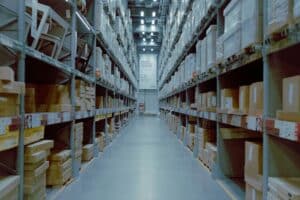Co-warehousing, Storage, Warehousing • 9 Minute Read • Mar 26, 2025
Different Types of Warehouses: 9 Options to Consider

Do you want a deeper understanding of the different types of warehouses? Are you a small to medium business owner, ready to move your business out of your living room and into a proper storage facility? Ready to take back your home from your business?
If so, you’ll want to balance use of space with shipping logistics and cost when picking a warehouse. Here are 9 types of warehouses to consider.
Why are there different types of warehouses?
There are different types of warehouses to fulfill specific needs of different businesses. Smaller organizations may not have the capital to buy or build a warehouse outright. So, they’ll need smaller or shared warehousing options to store products.
On the other hand, major corporations like Walmart, Target, or Amazon have much more capital to spend on storage. They likely find it worthwhile to invest in larger warehouses with smart capabilities to achieve efficient warehouse management practices and quick shipping times.
So it’s important to take the time to weigh all your options and pick a warehouse that’s a great fit for your business now, and as you scale.

#1: Public Warehouse
A public warehouse is a cost-effective storage solution for small to medium businesses that need flexible warehousing without the high costs of owning or operating their own facility.
These warehouses are owned and managed by third-party companies that lease space to multiple businesses. This allows said businesses to share costs for storage and logistics. This setup makes public warehouses an attractive option for startups, seasonal businesses, or companies experiencing growth that need additional space without long-term commitments.
The warehouse provider handles staffing, equipment, and operational expenses. So, businesses can avoid the financial and logistical burden of managing their own storage facility. Some public warehouses also offer extra services such as inventory management, order fulfillment, and transportation, which further streamlines operations.
Yet, there are some cons. Companies have limited control over how their goods are stored and handled due to many organizations using the space. These facilities may also lack advanced technological capabilities compared to private or dedicated warehouses, which could impact inventory tracking and order fulfillment efficiency.
If a business requires highly specialized storage conditions or wants some control over handling, a different warehousing option may be a better fit.
#2: Private Warehouse
A private warehouse, also known as a proprietary warehouse, is the most common warehouse type. It’s typically owned by the business that uses it to store its products.
This type of warehouse offers full control over storage conditions, operations, and logistics, making it a popular choice for wholesalers, distributors, and manufacturers with high-volume inventory needs. Some companies that own private warehouses may also lease out extra space to other businesses to offset some costs.
Additionally, private warehouses can provide third-party logistics (3PL) services for renters, helping businesses with inventory management, order fulfillment, and transportation.
That said, owning or renting a private warehouse requires a significant investment. While a large financial commitment, it does add a valuable asset to the business.
Leasing a private warehouse is often more expensive than using a public warehouse. Especially since these facilities are typically large and require long-term commitments. Operating costs, including staffing, equipment, and maintenance, can be high. Plus, it may take a while to see positive cash flow.
For businesses with steady demand and a need for full operational control, a private warehouse can be an excellent choice. Smaller businesses or those with fluctuating storage needs may find it cost-prohibitive.
#3: Smart Warehouse
A smart warehouse, or automated warehouse, uses AI-driven technology, robotics, and automated systems to handle storage, retrieval, and fulfillment processes with minimal human intervention. These facilities employ automated storage and retrieval systems (AS/RS), automated guided vehicles (AGVs), collaborative robots, and conveyor systems to streamline operations.
AI-powered tools can pack, weigh, transport, and store materials, ensuring a fast and efficient workflow. Orders are fulfilled as they come in, reducing delays and increasing order accuracy. This high level of automation makes smart warehouses ideal for businesses that require rapid fulfillment and minimal human error, such as large e-commerce companies.
As you can imagine, these warehouses require a significant investment in technology and infrastructure. The upfront costs for AI-driven systems and robotics can be substantial, making them more accessible to large corporations rather than small or medium businesses.
As automation technology becomes more affordable, smaller businesses may be able to adopt elements of automation to improve their logistics operations.
#4: Cowarehousing
A cowarehouse is a larger warehouse split up into multiple sections that are rented by multiple tenants. This enables small to medium sized businesses to store their goods in a warehouse at the fraction of a price of a traditional private warehouse.
Usually, the leases are also more flexible than traditional warehouses. This allows businesses to scale up or down as needed – helping newer or seasonal organizations manage the ebb and flow of business in a cost-efficient manner.
Other perks include office spaces, conference rooms, break rooms and kitchens, community spaces and event spaces. This makes the warehouse space you’re renting feel much larger than the actual footprint of your warehouse. Cowarehouses range from 200 to 5,000 square feet.
Industries that use cowarehousing include:
- Ecommerce companies
- Small businesses
- Local service providers
- Light manufacturers
- Startups
- Makers and creatives
- Nonprofits
#5: Government Warehouse
A government warehouse, also known as a municipal warehouse, is owned and operated by federal, state, or local government agencies to store goods. Some of which include:
- Military equipment
- Emergency supplies
- Confiscated goods (drugs, weapons, etc.)
- School supplies
- Hospital supplies
- Vehicles
These warehouses offer affordable rates and accessible storage, making them an option for businesses or organizations needing secure, cost-effective warehousing. The U.S. government owns or leases over 19,000 warehouse buildings.
While government warehouses provide increased security and affordability, they come with strict regulations, extensive paperwork, and intense application processes. However, for those that meet the requirements, a government warehouse can be a cost-effective and highly secure storage solution.
#6: Cold Storage or Climate-Controlled Warehouse
A climate-controlled warehouse is designed for businesses that need to store temperature-sensitive or perishable goods like pharmaceuticals, wine, or plants.
These facilities use HVAC systems, dehumidifiers, thermostats, and insulation to maintain a stable environment. This ensures inventory is protected from extreme temperatures and humidity fluctuations. Some climate-controlled warehouses are entire buildings, while others are specific sections within a larger facility.
Climate-controlled warehouses come at a higher cost than standard warehouses due to the specialized systems required to maintain consistent temperature and humidity levels. For businesses that need strict climate regulation, this type of warehouse is a necessary investment.
#7: Distribution Centers
A distribution center is a strategically located warehouse designed to temporarily store and quickly route goods to retailers, wholesalers, or customers.
Unlike traditional warehouses that focus on long-term storage, distribution centers serve as intermediaries between manufacturers and retailers, ensuring fast and efficient delivery. These facilities help businesses:
- Reduce transportation costs
- Minimize delivery times
- Improve inventory management
This makes them an affordable option for companies selling to wholesalers.
Distribution centers prioritize speed and efficiency. They are best suited for large distributors like Amazon, Walmart, and Target, which require rapid order fulfillment. For businesses looking to expand their reach, reduce storage costs, and streamline logistics, a distribution center can be an essential part of a scalable supply chain strategy.

#8: Fulfillment Centers
A fulfillment center is a type of public warehouse that provides turnkey order fulfillment services, making it a popular choice for eCommerce businesses looking to outsource logistics. These facilities handle every step of the fulfillment process, including receiving inventory, storage, order processing, picking, packing, and shipping.
A good example is the Amazon Fulfillment Center, which allows businesses to store their products while Amazon handles the packing and shipping directly to customers. This hands-off approach enables businesses to focus on customer service, marketing, and product development instead of warehouse and shipping logistics.
While fulfillment centers offer convenience and scalability, they can get expensive quickly. Especially for businesses with lower sales volumes or large, slow-moving inventory. Fulfillment centers are designed for fast order processing rather than long-term storage. So, fees can add up if products remain in stock for too long.
If you’re looking to streamline fulfillment, improve delivery speeds, and scale efficiently, a fulfillment center can be a powerful logistics solution.
#9: Bulk Storage Warehouses
A bulk storage warehouse is designed for businesses that need to store large quantities of a single product, such as grains, chemicals, or raw materials. They are typically located near production facilities to streamline supply chains and reduce transportation costs. Because they are built specifically for handling bulk items, they offer cost-effective storage solutions for industries that deal with high-volume inventory.
Bulk storage warehouses are efficient for managing and distributing raw materials. They are not ideal for businesses with diverse product lines or complex order fulfillment needs. These facilities are best suited for manufacturers, agricultural businesses, and chemical companies that need large-scale storage with easy access to production lines.
If your business relies on storing and moving high volumes of a single product, a bulk storage warehouse can provide efficient and economical storage.

Which Warehouse is Right for Your Business?
Now that you know the differences between the different types of warehouses, it’s time to pick out one. You’ll want to consider warehouse size, proximity to suppliers, customers, and transportation routes, cost, and growth potential before making a decision.
Rest assured, there is a great space out there to help your business reach the next level.
Are you looking for warehouse space in Atlanta? Book a tour of our cowarehouse, a cost-efficient and flexible way to grow your business.
Are you a small to medium business owner looking for other helpful tips and information about growing a business? Sign up for our newsletter (below) to get more helpful information, like this, delivered straight to your inbox.




